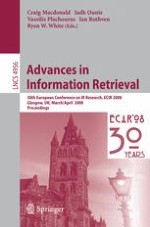2008 | Buch
Advances in Information Retrieval
30th European Conference on IR Research, ECIR 2008, Glasgow, UK, March 30-April 3, 2008. Proceedings
herausgegeben von: Craig Macdonald, Iadh Ounis, Vassilis Plachouras, Ian Ruthven, Ryen W. White
Verlag: Springer Berlin Heidelberg
Buchreihe : Lecture Notes in Computer Science
